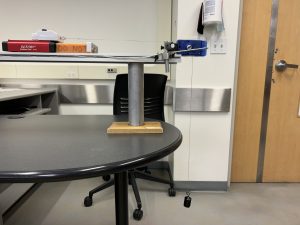Passive Forces Exercise 1
Passive Forces
Exercise 1
1.1 A block is held at rest on a frictionless horizontal track. One end of a string is attached to the block (cart + sensor) and the other to a cylinder which is hung over a pulley as shown. A hand presses on an upper horizontal surface of the system. (This upper surface is not frictionless.)

a) Draw a free body diagram for the block and a separate free body diagram for the cylinder, labelling the forces in the usual way. (Assume that the tension is the same everywhere in the string.)
b) How does the magnitude of the tension in the string compare to:
i) the weight of the cylinder?
ii) the horizontal force exerted by the hand on the block?
If necessary, modify your free-body diagram to reflect your conclusions.
c) What physical argument(s) did you use to compare the forces in part (b). Explain.
1.2 Suppose that the block is released.
a) Draw new free-body diagrams for the block and the cylinder.
b) How will the block and cylinder move when released?
c) How does the magnitude of the tension in the string compare to the weight of the cylinder? What physical argument(s) did you use to compare the forces? Explain.
d) How does the magnitude of the tension in the string in this case compare to the magnitude of the tension in the string when the block was held at rest?
e) In summary, what happens to the tension in the string when the block is released?
